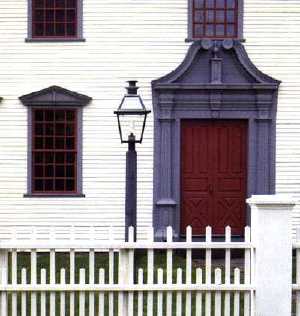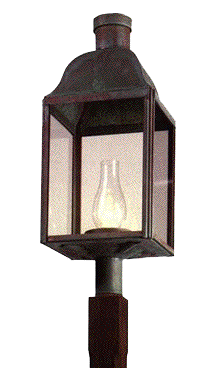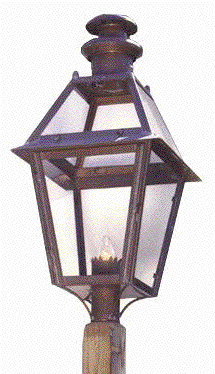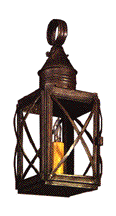|
Lantern History
 Early lanterns
were purely utilitarian, often square and plain in
design, whose original function was merely to
shield a burning candle. Most were primitive in
design and made from tinplate or sheet iron. Those
made of the more expensive materials are extremely
rare. Brass and pewter, for example were forged
into gun parts and moulded into bullets during the
Revolution. Early lanterns
were purely utilitarian, often square and plain in
design, whose original function was merely to
shield a burning candle. Most were primitive in
design and made from tinplate or sheet iron. Those
made of the more expensive materials are extremely
rare. Brass and pewter, for example were forged
into gun parts and moulded into bullets during the
Revolution.
|
|
 In the early
days, the colonists went to bed with the setting
sun or made do with fire light. One early
improvement was the lantern, or "lanthorne" as it
was known 200 years ago. Today lanterns mounted
outside the home are both decorative and
functional. They provide accent and ambient
lighting for visitors who need to safely reach your
door. In the early
days, the colonists went to bed with the setting
sun or made do with fire light. One early
improvement was the lantern, or "lanthorne" as it
was known 200 years ago. Today lanterns mounted
outside the home are both decorative and
functional. They provide accent and ambient
lighting for visitors who need to safely reach your
door.
|

|

|
 Streets in most American cities 200 years
ago were lighted primarily by reflections from
doorway lanterns. Few townships had established
provisions for public street lighting. Boston was
probably the first. In the early 1700's cressets or
iron baskets hung from poles with pine knots as
fuel and were used to light busy intersections.
These were tended by night watchmen. Some towns
passed laws making it mandatory for every sixth
house to have a post lantern or a torch to provide
the requisite illumination. Streets in most American cities 200 years
ago were lighted primarily by reflections from
doorway lanterns. Few townships had established
provisions for public street lighting. Boston was
probably the first. In the early 1700's cressets or
iron baskets hung from poles with pine knots as
fuel and were used to light busy intersections.
These were tended by night watchmen. Some towns
passed laws making it mandatory for every sixth
house to have a post lantern or a torch to provide
the requisite illumination.
 By the 1770's the city of Boston had large
numbers of post lanterns of English manufacture
lighting its streets. Whale oil was the fuel used.
By 1751 Philadelphia's streets were also lighted,
thanks to Benjamin Franklin. Ever resourceful, it
was he who discovered that two wick tubes burning
side by side a certain distance apart gave more
light than two separate burners. Different fluids
were also experimented with. One such fuel was
camphene. It was a combination of turpentine and
alcohol and burned very brightly, but was extremely
dangerous. By the 1770's the city of Boston had large
numbers of post lanterns of English manufacture
lighting its streets. Whale oil was the fuel used.
By 1751 Philadelphia's streets were also lighted,
thanks to Benjamin Franklin. Ever resourceful, it
was he who discovered that two wick tubes burning
side by side a certain distance apart gave more
light than two separate burners. Different fluids
were also experimented with. One such fuel was
camphene. It was a combination of turpentine and
alcohol and burned very brightly, but was extremely
dangerous.
|
|
 The gas light era was introduced in this
country about 1800, while in Europe, London first
switched to gas in 1807. The beautiful Westminster
Bridge was lighted by gas in 1813; Paris streets in
1818. Several significant discoveries increased the
brilliance of the gas light; pinching the end of
the gas tube to a fan shape, mixing air with the
gas before the point at which it was lit and
finally, surrounding the flame with a mantle of
metallic oxide cloth until it glowed brighter than
the flame were all important innovations in the
quest for more light. The gas light era was introduced in this
country about 1800, while in Europe, London first
switched to gas in 1807. The beautiful Westminster
Bridge was lighted by gas in 1813; Paris streets in
1818. Several significant discoveries increased the
brilliance of the gas light; pinching the end of
the gas tube to a fan shape, mixing air with the
gas before the point at which it was lit and
finally, surrounding the flame with a mantle of
metallic oxide cloth until it glowed brighter than
the flame were all important innovations in the
quest for more light.
|

|

|
 Legend has it
that a windowless, pierced lantern was used to
signal Paul Revere from the belfry of the Old North
Church of the arrival of the British, a noble task
for an ignoble lantern. We can be sure that such a
lighting device could never have been seen from
across the Charles River. Nevertheless these
pierced lanterns are named after the famous patriot
and the legend persists. Legend has it
that a windowless, pierced lantern was used to
signal Paul Revere from the belfry of the Old North
Church of the arrival of the British, a noble task
for an ignoble lantern. We can be sure that such a
lighting device could never have been seen from
across the Charles River. Nevertheless these
pierced lanterns are named after the famous patriot
and the legend persists.
|



